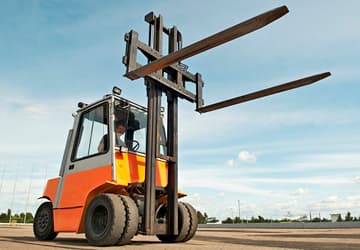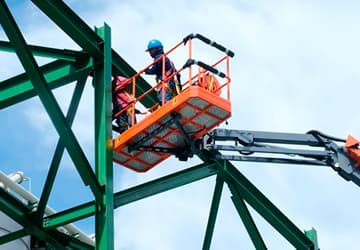When it comes to working at heights, safety and efficiency are paramount. Telescopic and articulating boom lifts are two popular aerial access equipment options that cater to different needs and scenarios. However, it’s important to note that cranes are also vital pieces of machinery used for lifting heavy loads in various industries and construction sites. In this blog, we’ll delve into the characteristics, applications, and benefits of both telescopic and articulating boom lifts, as well as a brief overview of different types of cranes to help you choose the right equipment for your specific job requirements.
I. Telescopic Boom Lift
A telescopic boom lift, also known as a straight or stick boom lift, is a versatile piece of machinery designed to reach greater heights with a straight, extendable arm. Here are some of its defining features:
- Vertical Reach: Telescopic boom lifts offer exceptional vertical reach, making them ideal for accessing high elevations that require a direct, unobstructed line of sight. They are commonly used in projects such as exterior building maintenance, tree trimming, and construction sites with open spaces.
- Horizontal Outreach: While telescopic boom lifts excel in vertical reach, their horizontal outreach is limited compared to articulating boom lifts. They are best suited for tasks that require direct access to a specific point without the need to maneuver around obstacles.
- Stability: Thanks to their rigid structure and straight arm design, telescopic boom lifts provide excellent stability, making them suitable for heavy-duty applications and rough terrains. Their stable platform ensures enhanced safety for workers operating at heights.
- Quick Setup: Telescopic boom lifts are relatively quick and straightforward to set up, making them a preferred choice for time-sensitive projects where efficiency is crucial.
II. Articulating Boom Lift
An articulating boom lift, often referred to as a knuckle boom lift, offers a more flexible and versatile solution compared to telescopic boom lifts. The key features of articulating boom lifts include:
- Articulating Arm: Articulating boom lifts are equipped with multi-jointed arms that allow for increased maneuverability. These arms can articulate or bend at multiple points, making it easier to reach around and over obstacles like walls, equipment, and structures.
- Horizontal Outreach: The most significant advantage of articulating boom lifts lies in their extensive horizontal outreach. They can navigate through tight spaces and access difficult-to-reach areas with precision, making them suitable for indoor projects, maintenance in crowded areas, and complex construction sites.
- Vertical Reach: While articulating boom lifts do offer impressive vertical reach, they are not as efficient in reaching extreme heights compared to telescopic boom lifts. As such, they are better suited for projects where horizontal access and positioning are the primary concerns.
- Terrain Adaptability: Articulating boom lifts often come equipped with features like non-marking tires and compact design, making them suitable for indoor applications on delicate flooring or congested spaces.


Cranes are essential pieces of machinery used for lifting, moving, and transporting heavy loads in various industries and construction sites. There are several types of cranes, each designed to serve specific purposes based on their configurations and capabilities. Here are some common types of cranes:
- Mobile Cranes: Mobile cranes are versatile and can be easily transported to different job sites. They are mounted on trucks or crawlers, making them suitable for a wide range of lifting tasks. Mobile cranes include:
a. All-Terrain Cranes: These cranes have both on-road and off-road capabilities, making them ideal for various terrains and environments.
b. Truck-Mounted Cranes: Mounted on trucks, these cranes are quick to set up and offer high mobility.
c. Crawler Cranes: Equipped with caterpillar tracks, crawler cranes provide stability on soft ground and are suitable for heavy lifting tasks.
d. Rough Terrain Cranes: Designed for rugged outdoor conditions, these cranes have large, robust tires and can handle challenging terrains.
- Tower Cranes: Tower cranes are commonly seen on large construction sites and are used for tall building projects. They are fixed to the ground and have a high lifting capacity. As the building grows in height, the tower crane’s height is increased through the addition of mast sections. They offer excellent stability and can handle heavy loads at great heights.
- Overhead Cranes: Overhead cranes, also known as bridge cranes, are installed in factories, warehouses, and industrial facilities. They consist of a horizontal beam that runs along tracks, allowing the crane to move goods horizontally. Overhead cranes are commonly used for material handling and production processes.
- Gantry Cranes: Gantry cranes are similar to overhead cranes but are supported on legs rather than being suspended from the ceiling. They are often used in shipyards, construction sites, and other outdoor applications. Gantry cranes come in various configurations, including single-girder and double-girder designs.
- Jib Cranes: Jib cranes have a horizontal arm (jib) that extends from a pillar or wall-mounted support. They are commonly used in workshops, loading docks, and small-scale lifting tasks. Jib cranes provide 180-degree or 360-degree coverage, depending on their design.
- Telescopic Cranes: Telescopic cranes feature a boom composed of telescopic sections that can extend and retract. They are highly mobile and often used in construction and material handling tasks.
- Floating Cranes: Floating cranes are mounted on barges or vessels and are used for maritime operations such as loading and unloading cargo from ships or offshore construction projects.
- Loader Cranes: Loader cranes are mounted on trucks and are used for loading and unloading cargo without the need for additional lifting equipment.
- Stacker Cranes: Stacker cranes are automated cranes used in warehouses and distribution centers to stack and retrieve pallets or containers from racks.
Each type of crane has its own set of advantages and is suited to specific applications. The selection of the appropriate crane depends on factors such as the type of load, lifting capacity, working environment, and the specific requirements of the job at hand.

